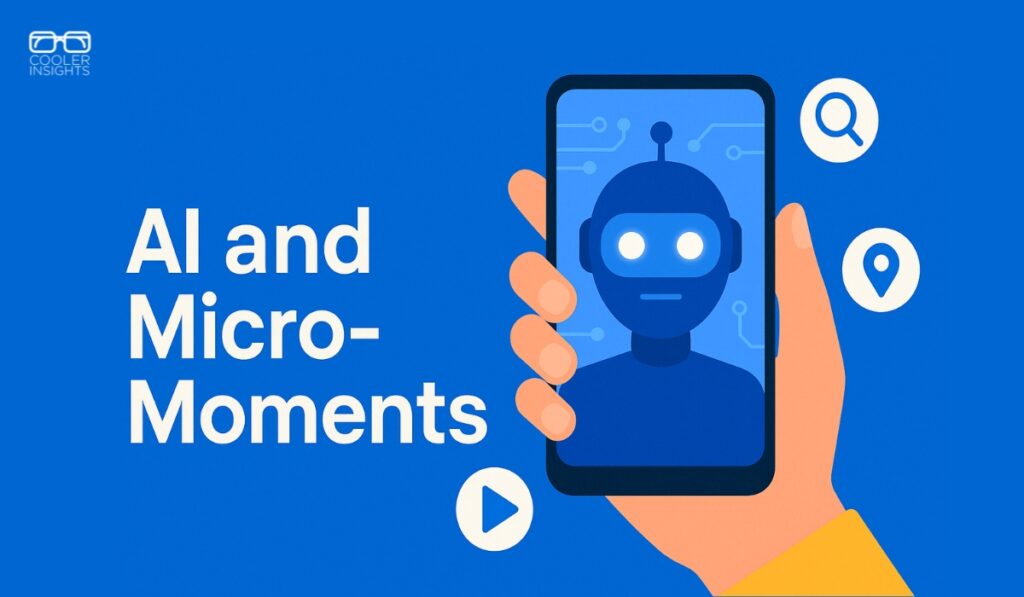
Every time someone grabs their phone to search, scroll, or shop, a micro-moment happens. It’s that split second when intent meets action—and if your brand isn’t there, you’re out of the picture.
To win in these moments, you need to have the right message to be present on the right channels at the right time.
Understanding the psychology behind such micro-moments allows marketers to tap into customer pain points and deliver target information that translates into sales.
However, knowing what language speaks to consumer needs requires figuring out how to get people’s attention. This is where AI may help.
What Is Micro-Moment Marketing?
Micro-moment marketing is a marketing strategy focused on reaching consumers at pivotal decision-making points throughout their day. These “micro-moments” are brief instances when people turn to a device like their phone to visit, do, buy or learn about something.
For example, imagine someone watches a cooking show, and a specific spatula catches their eye. Intrigued, they grab their phone to search for the spatula online, interested in buying one for themselves.
By understanding these intent-driven moments, brands can deliver relevant and immediate information that addresses a consumer’s specific need in that instant. Effective micro-moment marketing means brands must be present, speedy and genuinely helpful, providing seamless experiences that guide consumers toward a purchase or brand interaction.
Common Micro-Moments to Capture
Google points to advances in AI to help engineer ads and have the right products reach the people who need them. For marketers, this means homing in on users’ questions and delivering answers in a way machines understand.
Using AI to grab people while they are in the mood to buy can significantly impact revenue. Some of the types of micro-moments you can capture include:
- Want to know: These micro-moments reflect a person’s desire for knowledge. They might wonder who originally recorded a song, how many square feet are in the average home or what ingredients go in a particular recipe.
- Want to go: This micro-moment occurs when someone watches a scene in a movie, sees a photo of a friend’s vacation or hears about a destination. They search to learn more about the costs and potential packages for a trip.
- Want to do: When consumers search for what to do, they want entertainment or to learn a new hobby or skill. They might search for events in an area or entertaining activities.
- Want to buy: This micro-moment happens when consumers seek products to resolve pain points.
How to Enhance Micro-Moment Marketing With AI
Companies that reach people at the right moment with the best message will benefit from the interaction by building brand awareness or fixing a customer’s problem. Fortunately, AI is adept at figuring out messaging and timing based on what others have done successfully. Those who wish to compete in a global marketplace must embrace the power of this modern technology.
Experts estimate most companies — nearly three-quarters of businesses — will use AI in various forms by 2030.
Here are the top ways to tap into the power of machine learning to improve your micro-moment reach.
Utilize Personalization Options
AI can take massive amounts of customer data and spit out insights to help drive marketing campaigns. Getting into the nitty gritty of what your customers want gives you a better chance of selling to them. Use AI to dig into the behaviors of your customer base, determine their pain points and identify how your product solves them.
Predict Customer Intent
AI is adept at tracking customer behavior patterns and adjusting your website’s content depending on those patterns and shifts. For example, a customer looking for formal gowns in March is likely shopping for prom, while someone seeking such information in June may be trying to find bridesmaid or wedding guest dresses.
Having insight into what people need at the moment they are ready to order can increase conversions.
Utilize Natural Language Processing to Grab Attention
Machines are constantly learning how to interact with customers and answer basic queries. One study showed that 90% of marketing professionals in 35 countries turned to AI to automate customer conversations.
Rather than putting customers on hold or waiting for a live agent to connect, grab users by giving them an instant response from an AI chatbot.
Tap Into the Power of Voice Search
Voice search is becoming more commonplace. Programming software to respond to user requests can enhance instant interaction time and make a conversion more likely than if a customer has to wait for an email response or someone to answer their phone call.
Participate in Real-Time Design Tests
In the past, designers had to create various versions of websites and test them with different users. With the help of AI, business leaders and marketing professionals can run scenarios based on historical user interactions and see the likeliest outcomes. Management can determine design changes instantly and drive results for companies.
Micro-Moments Can Happen Now
The little interactions that drive consumers to your website happen in a flash. Keeping up with the competition and understanding what users want requires massive data. Only AI can quickly sort through all the details and decide the best path forward.
Brands that tap into the power of AI will see more success than those that ignore this valuable tool of the future.

Eleanor Hecks is a design and marketing writer and researcher with a particular passion for CX topics. You can find her work as Editor in Chief of Designerly Magazine and as a writer for publications such as Clutch.co, Fast Company and Webdesigner Depot. Connect with her on LinkedIn or X to view her latest work.
